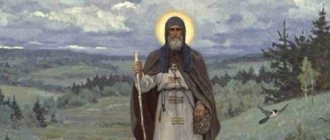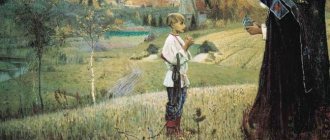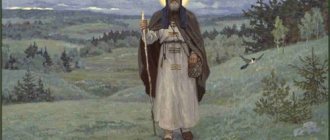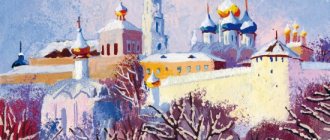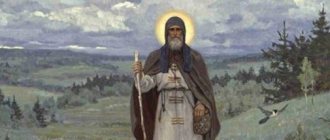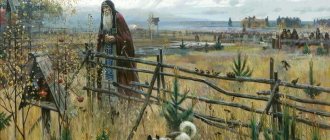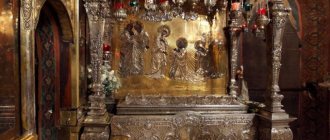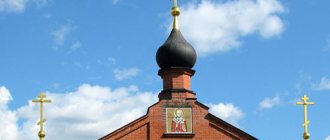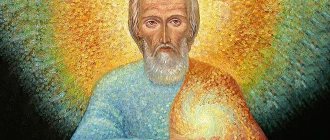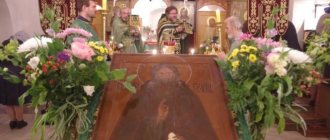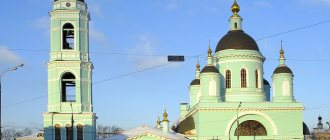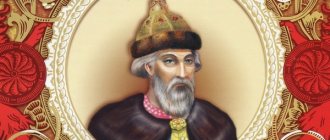Retelling of the life of Radonezh
Ancient Russian literature requires especially careful reading and understanding of the genre's features. Not everything in it is true, but not every fact is fiction. Hagiography is a genre that originated in ancient Rus' and became one of the treasures of Christian culture. A description of the life of Sergius of Radonezh appeared among the very first “hagiography” books, but its contents have been carefully preserved over the centuries.
The monk strove all his life for monastic life, but was in no hurry and took monastic vows only when he felt that he was ready to resist demons, temptations and bring the righteous faith to people. He lived a long life (according to some sources 70, according to others 78 years). And people remembered him as a Wonderworker, whose prayer performed incredible deeds.
“The Life of Sergius of Radonezh,” a brief retelling of which will help you prepare for the lesson, begins with the birth of a child in the family of a princely subject, boyar Kirill. His wife gave birth to a third child, and two other boys were already growing up in the family. Maria realized that an unusual child would be born when, during a service in the temple, a child’s cry was heard from her womb. The priest at the temple reassured the woman, saying that her son would be a servant of the Holy Trinity.
The Reverend's Boyhood
Upon reaching adolescence, the parents sent their son to learn to read and write, but science was not given to the boy. Unlike his brothers, he could not read even a few words, and the letters were not remembered at all. Bartholomew (that was the name of the ascetic in childhood) suffered daily from the punishments of his father and teacher. He spent his free time in prayer, asking the Almighty to enlighten him.
To pray, the boy chose secluded places, went into fields or forests. So one day he met a seer under a spreading oak tree. He recognized the chosen one of God in the boy, and the boy told him about his misfortune. The elder went to Bartholomew's parents and told them that God had chosen the unborn baby in the womb. After the disappearance of the seer, the mother and father were surprised to see that their son could read and write fluently and competently.
The boy surprised and at the same time upset and worried his parents with his behavior. He did not eat any food on Wednesdays and Fridays, observed fasting, devoted all his time to reading the holy scriptures and did not miss a single service.
Path to God
Over time, the family moves to the Radonezh lands and settles there. The older brothers get married with the blessing of their parents, have children, and Bartholomew asks his father and mother for a blessing to serve God. In return, they ask to fulfill their dying request - to bury them with prayer and give alms to the poor. The young man gives the bequeathed inheritance to his older brother, and with his middle brother he goes to the wasteland and builds a small church there. In it, he celebrates his 20th birthday by becoming a monk. Life in the forest was difficult, Stefan could not stand the test and took monastic vows, began to live in the Epiphany Monastery in Moscow, and served as a confessor at the princely court.
Monastic feat
During his ordination as a monk, the young man received the name Sergius, and the church was named in honor of the Holy Trinity. For a long time the monk lived alone and also independently fought temptations, the devil, and demons with the strength of spirit and prayer. Prayer helped him. Wild animals also came to the church; Sergius fed the forest bear for more than a year, who came to the monastery every day for a piece of bread.
Monks from other churches occasionally visited the saint. They wanted to live with Sergius, but he stubbornly resisted, feeling sorry for the people, realizing that his life was difficult and harsh. But when some monks became especially persistent, he had to allow them to build cells and live with him. Together they served the morning service and prayed at night, and invited a priest to the lunch service, since none of the monks, including Sergius, had the rank of abbot.
Through humility, daily work and hardships, Sergius proved his faith in God to himself and the Almighty. He worked in the garden, chopped wood, carried water, prepared food and prosphora, and melted candles. The monastery began to develop when Bishop Athanasius ordered the ascetic to become abbot and serve the Church. And gradually more and more people began to flock to Sergius’s monastery. Everyone wanted to see the man about whose strength of faith there were rumors and legends. Many were speechless in amazement when they saw the abbot in dirty, torn clothes, working in the garden. The priest prayed for a source of water to appear near the monastery, and soon a holy spring began to flow next to the church.
Miracles
The author wrote about the inexplicable phenomena that occurred in the life of Sergius from the words of those who were eyewitnesses. So, one day there was absolutely nothing to eat in the monastery; the monks had only been drinking water for several days and had not eaten a piece of bread. But Sergius forbade them to beg and ordered them to pray. Miraculously, a convoy with food appeared in front of the gates to the monastery, the food was unloaded and the convoy disappeared.
Having heard about the miracles that Sergius’ prayer works, one man brought his dying son to him. The boy died, and the grief-stricken father went to prepare everything necessary for the burial. When he returned to collect the body, he was amazed to find that his child was alive and no longer suffering from the disease.
Another time, a possessed rich man was brought to the elder. He had been tormented by demons for many years, and when the man was taken to the monastery, he screamed so that his voice could be heard even in distant cells. The monk crossed the possessed man with prayer to the loud ringing of bells, and he lay down in a puddle and, when he stood up, was completely freed from the misfortune. It turns out that while reading a prayer, the patient saw that the cross was blazing with flame. He was afraid of the fire and fell into a puddle.
St. Sergius died in 1393. His life's work gave rise to the formation and prosperity of the largest monastery in the world - the Sergius Trinity Monastery.
Where are the icons located?
The Venerable Father Sergius is depicted on single and hagiographic icons. He was often depicted at full length in a cassock, because he was a monk all his life. In the hagiographic icons, artists painted an image of Father Sergius in the center, and about 17-20 scenes from his life along the edges. In each mark you can see what the hieromonk did - he healed the sick, prayed, blessed the soldiers for victory.
In the Holy Trinity Lavra of Sergius in the Moscow region, in Sergiev Posad, there are the relics of the saint. The remains and holy icon of the hieromonk are available in the courtyard of the Trinity-Sergius Lavra in the Church of the Life-Giving Trinity, as well as in the Church of St. Nicholas in Klenniki, in the Moscow Church of Elijah the Obydeniy. In the village of Bibirevo, in the Church of St. Sergius, there is an ancient icon that commemorates salvation from cholera in the 19th century. The collection of the Andrei Rublev Museum contains an icon of the hieromonk with 17 marks of his life. An image of the saint is found in almost every church.
The author's main idea
The saint lived and served the faith at turning points, when a new era in literature and fine arts was emerging. The hagiographic genre was aimed at preserving historical events, telling stories about people who contributed to the history, culture and development of Orthodoxy in Rus'. At the same time, a certain verbal style developed, with the help of which Epiphanius the Wise composed his “Life...”.
The text is filled with epithets, symbolism, metaphors; it is quite difficult to perceive without preparation. We recommend reading “The Life of Sergius of Radonezh” briefly in 8th grade in order to understand what this work is about, and only after that proceed to detailed reading.
Analyzing “The Life of...”, you will understand that the author’s main goal is a story about a man who made a great contribution to the spread of Christianity, changed people’s lives for the better, helped the suffering and at the same time remained a humble servant of God.
(for reading and studying in grades 7, 8)
Sergius of Radonezh is one of the holy leaders of the Russian land, according to historian V.O. Klyuchevsky, his name “shines as a bright constellation in the 14th century, making it the dawn of the political and moral revival of the Russian land. Sergius, with his life, the very possibility of such a life, made the grieving people feel that not all good in them had yet extinguished and froze... He opened their eyes to themselves.” “By the example of his life, by the height of his spirit, St. Sergius raised the fallen spirit of his native people, awakened in them confidence in himself, in his strengths, and inspired faith in his future.”
IN. Klyuchevsky speaks of admiration for the personality of Sergius for five centuries1 and characterizes the thoughts and feelings of pilgrims returning from the Sergius Lavra to all ends of the Russian land. “Even during the life of the Reverend, many people came to him from various countries and cities, among those who came were monks, princes, nobles, and ordinary people “living in the countryside.” Statesmen and ordinary people came to him with their thoughts and feelings at difficult turning points in people's lives, in sad or joyful moments of their lives. “And this influx did not change over the centuries, despite repeated and profound changes in the structure and mood of Russian society: old concepts dried up, new ones made their way or floated, and the feelings and beliefs that attracted people here from all over the Russian land still prevail today with the same fresh spring as they beat in the 14th century.” These feelings are an expression of the moral life of the people. They become fused with the image of Sergius; they are its nutritious soil; in them are his roots; tear it away from them - it will wither like mown grass. “By creating the memory of St. Sergius, we examine ourselves, review our moral stock, bequeathed to us by the great builder of our moral order.” His moral influence is great; the bright and strong impressions made by Sergius sank into the souls of the people. The great Russian ascetic delighted and surprised foreigners. The Bishop of Constantinople, having arrived in Moscow, exclaimed: “How can such a lamp appear in these countries?”
The Russian people of the 14th century recognized this manifestation of the spiritual influence of Sergius as a miraculous creative act. It “survived his earthly existence and poured into his name, which from a historical memory became an eternally active, moral engine and became part of the spiritual wealth of the people”2.
“Political fortress” is strong only when it rests on moral strength - this is the most precious contribution of St. Sergius to the living soul of the people, their moral self-awareness. This is modern even today.
Obedience of Sergius of Radonezh
This is probably one of the most famous episodes in the life of St. Sergius: his father, a once wealthy Rostov boyar, saw in his son a successful socialite who would help their impoverished family return to the “high society.” They became poor precisely because of another princely feud.
Having learned that the young man had made a firm decision to become a monk, his father asked him to stay - at least until he and his mother died.
Obedience is not “unhappy agreement,” but correctly set priorities within the soul that make a person more correct and freer. The Monk Sergius remained at home, as his parents asked, and began his monastic journey immediately after their death - thereby strengthening himself and avoiding any turmoil in the family.
Why is St. Sergius of Radonezh so revered?
However, if the life of St. Sergius had been reduced only to these facts of life, he would not have been a saint. Because both before and after him people went into the forests. Each of the 950 Russian monasteries also has its own founder. Diplomacy and peacemaking are also not the path to holiness. And taking a blessing before a battle is a well-known tradition in Rus'.
St. Sergius was loved then and is revered now, because he was a model. The life of almost every saint is a model, but St. Sergius of Radonezh personified a truly wonderful example. His way of life revealed true Christianity - when a person is meek, free from passions and human conventions, but at the same time calmly fits into them and even influences them - changing the world around him. In essence, St. Sergius personified the image of a happy person.
But the main thing: from what this saint became famous for, there is nothing that would be unattainable for any of us.
The life of St. Sergius of Radonezh is a collection of inspiring examples of how to become happy in the true sense of the word.
Icon of St. Sergius of Radonezh. Around the central image are displayed the main moments from the life of the saint: from birth to death.
